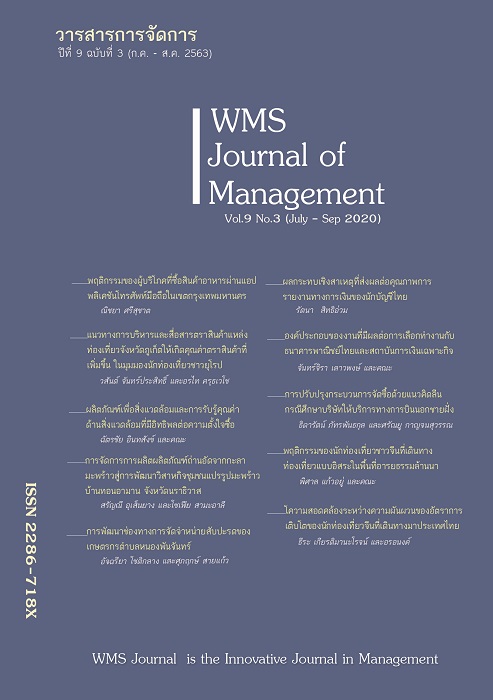Behaviour of Independent Chinese Tourists Travelling in Lanna Civilization Area, Thailand
Main Article Content
Abstract
The study entitled “Behaviour of Independent Chinese Tourists travelling in Lanna Civilization Area, Thailand was aimed at exploring the circumstances in which independent Chinese tourists travelling in Lanna Civilization Area and their behaviour when travelling in the area. The data were obtained s through observation and an in-depth interview with the government sectors and private sectors as well as 100 independent Chinese travelling in Chiang Mai, Chiang Rai, Pha Yao, Lampang and Lamphun. The results revealed that the number of independent Chinese tourists tended to increase constantly, and most of them belonged to tourist group of Gen Y and new generation who searched for new experiences and focused more on quality tourism. Accordingly, the study suggested seven cardinal aspects of Chinese tourists’ behaviour that should be prioritised: 1) shopping 2) accommodation 3) tourist activities 4) attraction 5) accessibility 6) communication and media and 7) planning.
Article Details
References
Dichter, A., Chen, G., Saxon, S.,Yu, J., & Suo, P. (2018). Chinese tourists: Dispelling the myths. An in-depth look at China’s outbound tourist market. China. McKinsey & Company.
Kamjinda, N. (2014).Sưksāsakyaphāplækhītkhwāmsāmātkhō̜ngphūprakō̜pkānthainaikānrō̜ngrapnakthō̜ngthīaochāočhīn [The Potential Capabilities of Thai Tour Operation. For Supporting Chinese Tourists]. Kasetsart University, Bangkok.
Li, X., Lai, C., Harrill, R., Kline, S., & Wang, L. (2011). When east meets west: An exploratory study on Chinese outbound tourists’ travel expectations. Tourism Management, 11(32), 741-749.
Ministy of Tourism and Sports. (2019). sathiti nakthō̜ngthīeo phāinai prathēt 2018. [Domestic Tourism Statistics 2018]. Retrieved from
https://www.mots.go.th/ more_news.php ?cid=411
Parasakul, L. (2015). Phopwā Rǣngčhūngčhailæthatsanakhatithīsongph ontō̜khwāmphưngphō̜čhaidōirūamkhō̜ngn akthō̜ngthīaochāočhīntō̜kānthō̜ngthīaoprat hedthai [The Motivations and the Attitudes Affecting the Satisfaction Level of Chinese Tourist’s Visiting Thailand]. Bangkok.
Pitikaison, P. (2019). phrưttikam thō̜ngthīeo Čhīn plīan! næ thurakit prap tūa [Behaviour of Chinese Tourists to Change!. Business needs to adapt]. Retrieved from https:// www.scbeic.com/th /detail/product/5833
Roger St, G.M., & Arch, G. (2005). Tourism Behaviour Traveller’ Decisions and Action. London, UK: CABI Publishing is a division of CAB International.
Samittarangkoon, J.S. (2014). phrưttikam kān bō̜riphōk khō̜ng nakthō̜ngthīeo chāo Čhīn nai čhangwat Chīang Mai [Behaviour of Chinese Tourists in Chiangmai]. Retrieved from http://resource.tcdc.or.th /ebook/JS-Chinese- tourist-study.pdf
SM Magazine (2019). phrưttikam nakthō̜ngthīeo Čhīn tit nưp ʻālī phē phon samrūat pī lāsut chī chat čhāi ngœ̄n phān mư̄ thư̄ sǣng nā ngœ̄nsot lǣo [Behaviour of Chinese Tourists to Popular Alipay for pay on smart phone more than Cash]. Retrieved from https://www.smmagonline .com /2019/02/04/
Suteerachat, J. (2019). SCB EIC mō̜ng Čhīn han pao sētthakit pī sō̜ngphansipkāo lư̄a tō 6.0 - 6.5 kō̜ kā tam thīsut nai rō̜p kư̄ap sāmsip pī. [Looking at China cutting economic targets for 2019 to 6.0- 6.5 percentage, the lowest in almost 30 years]. Retrieved from https://www.hooninside.com/news- feed/98548/view/
TAT Intelligence Center - TATIC. (2019). Nakthō̜ngthīaolonmư̄ang [over touirsm]. Retrieved from http://marketingdb.tat. or.th/documents/10181/180455/Thecomp ass1.pdf/f99da57e-521e-4669-aa2f- 549fbbcd419b
Thai Biz in China Thailand Business Information Center in China Royal Thai Embassy Beijing. (2019). Thai khrō̜ng chǣ prathēt paomāi khō̜ng nakthō̜ngthīeo sān sī sī pīsō̜n [Thailand champion for Destination of Shaanxi Tourists 4 Consecutive Year]. Retrieved from https://www.thaibizchina.com
Tourism Development Board of the Lanna Civilization Tourism Development Zone. (2015). Phǣnpatibatkānphatthanākān thō̜ngthīao Phāinaikhētphatthanākānthō̜ng thīaoʻārayathamlānnā [Tourism Development Action Plan Within the LannaTourism Development Zone].
Ministry of Tourism and Sports. Bangkok.
Yeumoy, L.Y., & Phongpanichanan, C. (2014). Does the status of a UNESCO World Heritage City make a destination more attractive to Mainland Chinese tourists? A preliminary study of Melaka. Taylor’s University. Malaysia. Procedia - Social and Behavioral Sciences, 14(144) 280 – 289.
Zhongguancun Science Park. (2019). WeChat eyes empowering global tourism services for outbound Chinese travelers. Retrieved from http://www.chinadaily.com.cn/m/be ijing/zhongguancun/201911/28/content_375 26299.htm

